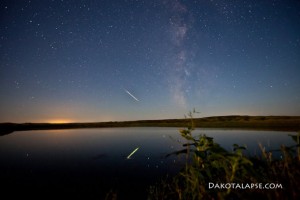 Tonight is one of the odder meteor showers of the years. Why is it odd? Well for one, it’s called the Quadrantids – named after a constellation that got redefined years ago and no longer exists. For another, the parent object of the shower isn’t a comet, it’s an asteroid that used to be a comet. And third, the shower peaks very sharply, coming and going in only an hour or two!
Tonight is one of the odder meteor showers of the years. Why is it odd? Well for one, it’s called the Quadrantids – named after a constellation that got redefined years ago and no longer exists. For another, the parent object of the shower isn’t a comet, it’s an asteroid that used to be a comet. And third, the shower peaks very sharply, coming and going in only an hour or two!
Here’s the deal.
First, meteor showers occur when the Earth plows through a trail of debris in space, usually left by a comet orbiting the Sun. The meteoroids – the solid bits of material – are usually very small, no bigger than a grain of sand. As they plow through our atmosphere at speeds of dozens of kilometers per second, they burn up, turning into meteors (if they hit the ground they’re called meteorites, which is very rare). Normally, you can see several random meteors every hour on a dark night, but during showers there may be dozens.
The length of time a shower lasts depends on how wide the debris field is. For most meteor showers it’s millions of kilometers wide, and so the showers can take days to play out. But the stream for the Quadrantids is very narrow, and the shower lasts for only an hour or so! It peaks tonight around 2 - 3 a.m. Eastern US time (07:00 - 07:00 GMT). That’s not an exact period, so if you want to see them you should go out an hour or so before then. There may be as many as 100 meteors per hour during that time!
Unfortunately, the waxing gibbous Moon is up tonight, so it’ll wash out a lot of the shooting stars. People on the east coast of the US have the best shot, since the Moon will hopefully have set by the time the shower peaks. However, Central time zone folks have a good view too since the Moon will be low to the horizon. I’ll give it a try tonight, since it peaks at midnight my time (in Boulder) and that’s early enough even for me to stay up.
How do you watch? All you need is an open sky and a place to lie down and relax. Someplace dark, away from trees and buildings is best. Meteors zip across the sky, so the more sky you see the better. I have a page with general advice on how to watch meteor showers that’ll help. It was written for a different shower, but the advice still applies.
As I said, meteor showers come from debris shed by comets as they orbit the Sun. These bits of stuff more or less follow the same orbit as their parent comet, and we get showers when the Earth rams through this material. However, the Quadrantids come from an object called 2003 EH1, which looks more like an asteroid – comets usually have lots of ice, but this object doesn’t. However, it’s on a comet-like orbit, so it most likely used to be a comet long ago which lost all its ice, leaving just rocky material behind.
And finally, the name: meteor showers appear to radiate from one point in the sky, in much the same way all the lights in a tunnel seem to be coming from ahead of you as you drive through that tunnel. Showers are named after the constellation where the meteors appear to come from: the Perseids for Perseus, the Orionids for Orion, and so on. Constellations are arbitrary boundaries in the sky, like state or county lines. Quadrans Muralis was a constellation defined back in the 19th century, and still existed when the Quadrantids were named, but was divided up when the modern official lines were drawn in 1930. That part of the sky is near the tail of the Big Dipper; so the meteors will appear to radiate away from the north across the sky.
So again, what to do: find a dark, open site. Try to bring a chaise longue or something where you can lie back and see lots of sky. Looking straight up is best. You don’t need binoculars or a telescope or anything like that: just your eyes, and a sense of wonder. Meteor showers can be a lot of fun, so I hope you see some good ones tonight!
Image credit: Randy Halverson. That’s not a meteor from the Quadrantids, but it’s still pretty.
Related posts:
- 12 things you need to see the Perseid meteors Sunday night (a general guide to meteor shower observing)
- What a falling star looks like… from space!
- New meteor shower points to a future close encounter
- Will the Leonids roar in 2009?